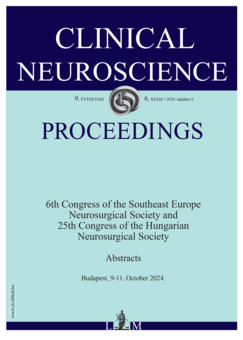Neurosurgical Tehnological developments in SKB Mostar
DAMIR Puljic1
2024. OKTÓBER 09.
Ideggyógyászati Szemle Proceedings - 2024;9(6)
DAMIR Puljic1
2024. OKTÓBER 09.
Ideggyógyászati Szemle Proceedings - 2024;9(6)
Szöveg nagyítása:

In the last couple of years, as technology develops in all fields, we also note progress in medicine. The development of technology in medicine greatly helps the medical staff to do their work for patients as precisely, easily and efficiently as possible. At SKB Mostar, we have the pleasure of working with modern technology, of which I would like to single out:
- Kinevo 900 microscope.
- Brainlab Curve navigation.
- Ultrasound bk5000.
- Neuromonitoring.
1. On the microscope, we have the option of audio and video recordings. In addition, we have the functions of recording angiography in brain blood vessel operations, and blue and yellow light, which in combination with contrast provides coloring of tumor formation in the brain.
2. Navigation is a combination of physics, mathematics and computer science. Using navigation, we determine the exact localization of the tumor formation. In addition to localization, it gives us information about how much tumor mass we have removed, and helps us not to damage some centers during the operation. I would single out adaptive hybrid surgery as one of the special possibilities of navigation.
3. Ultrasound bk 5000 has 3 neurosurgical probes that show us the actual (current) condition of the operative field. With the help of ultrasound, we can do a biopsy of the process on the brain, which enables a faster intervention and faster recovery.
4. Neuromonitoring serves us to monitor the evoked potentials, with which we monitor the motor and sensory during the operation.
5. Brainlab loop X is an intraoperative CT device that enables 2D and 3D image display. We use it in spine surgery.
This technology enabled us to perform complex procedures, as well as faster and more precise procedures. The future brings us new challenges, but with development and good education, we will try to overcome them successfully.
Ideggyógyászati Szemle Proceedings
Despite evidence based institutional protocols being in place in many countries, aneurysmal subarachnoid hemorrhage (SAH) continues to be a major socio-economic burden with many open questions remaining regarding the optimal management of the affected patients.
Ideggyógyászati Szemle Proceedings
Arteriovenous malformation (AVM) is an anomaly of blood vessel formation. Numerous models have been established to understand the nature of AVM.
Ideggyógyászati Szemle Proceedings
Additive manufacturing has gained significant traction in industrial applications due to its high potential when it comes to manufacturing objects with complex geometry.
Ideggyógyászati Szemle Proceedings
Not only other surgical and robotic fields, but minimally invasive procedures in spine surgery have undergone significant development in recent times. A demand emerged from both surgeons and patients to develop and perform these types of surgeries in order to prevent biomechanical and surgical complications.
Ideggyógyászati Szemle Proceedings
Functional magnetic resonance imaging (fMRI) is crucial for presurgical language mapping in neurosurgery, helping identify eloquent brain regions to preserve during operations. Effective language mapping depends on advanced fMRI acquisition and detailed data analysis to ensure accurate clinical outcomes.
Ideggyógyászati Szemle Proceedings
Functional magnetic resonance imaging (fMRI) is crucial for presurgical language mapping in neurosurgery, helping identify eloquent brain regions to preserve during operations. Effective language mapping depends on advanced fMRI acquisition and detailed data analysis to ensure accurate clinical outcomes.
Ideggyógyászati Szemle Proceedings
Tumors in and around brain stem remain one of the biggest neurosurgical challenges due to com- plex anatomy of this “high valued real estate area.
Ideggyógyászati Szemle Proceedings
Spontaneous spinal epidural hematoma (SHE) is a rare entity. Surgical decompression and evacuation are the gold standard for therapeutic management. However conservative treatment can be proposed in rare cases.
Ideggyógyászati Szemle Proceedings
Functional mapping of eloquent brain regions is crucial for effective surgical planning. fMRI of- fers a non-invasive approach to precisely localize eloquent regions responsible for language and motor functions.
Ideggyógyászati Szemle Proceedings
Large hemispheric infarction occurs in 10% of stroke cases, resulting in progressive cerebral edema and secondary nervous system damage alongside primary brain injury. Decompressive craniectomy (DC) has shown promising outcomes in mitigating mortality and morbidity associated with malignant cerebral edema (MCE).
A KORSZERŰ NUKLEÁRIS MEDICINA LEHETŐSÉGEI AZ ONKOLÓGIÁBAN
The role of middle meningeal artery embolization in the treatment algorithm for chronic subdural hemato- ma, latest evidence and our own experience
1.
2.
3.
4.
5.
Egészségpolitika
Hadiállapotként kezeli és így is reagál a kormány az egészségügy „rendezésére”1.
2.
3.
4.
5.